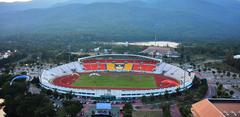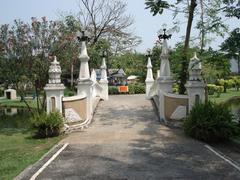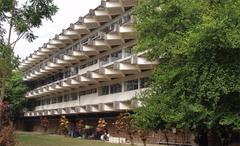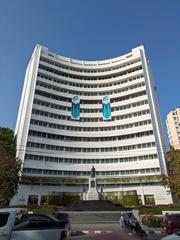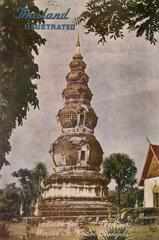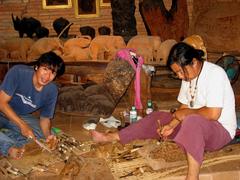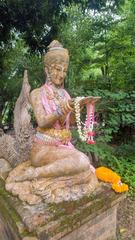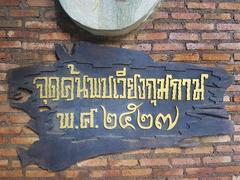Comprehensive Guide to Visiting Wat Chedi Luang, Chiang Mai, Thailand
Date: 16/08/2024
Introduction
Nestled in the heart of Chiang Mai, Thailand, Wat Chedi Luang stands as a remarkable testament to the region’s rich cultural and historical heritage. Known for its towering chedi and intricate architectural details, Wat Chedi Luang offers visitors a serene retreat and a captivating glimpse into the past. This ancient temple, built during the reign of King Saen Muang Ma in the 14th century, serves as a significant religious site, drawing visitors from around the world who come to explore its historical significance and spiritual importance (Travel Triangle). Whether you are a history buff, an architecture enthusiast, or a spiritual seeker, this comprehensive guide will provide essential information on Wat Chedi Luang’s history, visitor details, travel tips, and more. From the revered Emerald Buddha to the resilient structures that survived a devastating earthquake, every facet of Wat Chedi Luang tells a story of resilience and enduring cultural significance.
Table of Contents
- Introduction
- Origins and Construction
- The Emerald Buddha
- Earthquake and Damage
- Restoration Efforts
- Architectural Significance
- The Viharns (Assembly Halls)
- The City Pillar (Lak Mueang)
- Wat Phan Tao
- Modern-Day Significance
- Special Events and Guided Tours
- Photographic Spots
- Visiting Tips and Visitor Information
- How to Reach
- FAQ
- Conclusion
Origins and Construction
Wat Chedi Luang, located in the heart of Chiang Mai, Thailand, has a storied history that dates back to the 14th century. The temple’s construction was initiated by King Saen Muang Ma, who intended to build it in honor of his father. However, the construction faced numerous challenges and took over a decade to complete. After King Saen Muang Ma’s death, his widow continued the project, and it was finally completed in the mid-15th century during the reign of King Tilokaraj. Upon completion, the chedi (stupa) stood at an impressive 82 meters tall and 54 meters wide, making it the tallest structure in the Lanna Kingdom at the time (Travel Triangle).
The Emerald Buddha
In 1468, Wat Chedi Luang gained significant prominence when the revered Emerald Buddha was placed within its walls. The Emerald Buddha is one of Thailand’s most sacred religious relics, and its presence at Wat Chedi Luang elevated the temple’s status considerably. However, in 1545, a devastating earthquake struck Chiang Mai, causing the top part of the chedi to collapse. As a result, the Emerald Buddha was relocated to Luang Prabang in 1551 (Travel Triangle).
Earthquake and Damage
The earthquake of 1545 was a pivotal event in the history of Wat Chedi Luang. The natural disaster caused significant structural damage, reducing the height of the chedi from 82 meters to approximately 60 meters. Despite the damage, the temple continued to be an important religious site. The chedi’s base, adorned with elephant sculptures and naga (serpent) flanked staircases, remained largely intact, preserving its architectural grandeur (Jacknites).
Restoration Efforts
In the 1990s, a major restoration project was undertaken to stabilize and restore Wat Chedi Luang. This effort was supported by UNESCO and the Japanese government. The primary goal of the restoration was to prevent further deterioration of the structure. However, the restoration was not without controversy. Some critics argued that the restoration did not accurately reflect the original design and construction techniques. Despite these criticisms, the restoration successfully preserved the temple’s historical and cultural significance (Travel Triangle).
Architectural Significance
Wat Chedi Luang is renowned for its architectural and artistic features. The chedi, constructed with brick and mortar, features four sides, each with a staircase leading to a niche that houses a Buddha image. The eastern niche is particularly significant as it once housed the Emerald Buddha. The base of the chedi is surrounded by 32 elephant sculptures, symbolizing stability and strength. The chedi itself represents Mount Meru, the center of the universe in Buddhist cosmology, and serves as a symbol of the Buddha’s enlightenment (Travel Triangle).
The Viharns (Assembly Halls)
The temple complex of Wat Chedi Luang includes two viharns (assembly halls), each with distinct architectural styles and purposes. The larger viharn, known as Viharn Luang, was rebuilt in 1928 after a fire. It features a grand multi-tiered roof and an ornate façade adorned with gold leaf and intricate carvings. Inside, it houses the Phra Chao Attarot, a towering standing Buddha image from the 14th century, surrounded by murals depicting the Buddha’s life and the Jataka tales. This viharn is the focal point for major ceremonies and festivals, such as Visakha Bucha Day and the Inthakin Festival (Travel Triangle).
The City Pillar (Lak Mueang)
Another significant feature of Wat Chedi Luang is the City Pillar (Lak Mueang), known as Sao Inthakin. The City Pillar is believed to protect the city and ensure its prosperity. It is housed in a small building within the temple grounds, adorned with beautiful murals and a gilded Buddha statue. The City Pillar is an important cultural and religious symbol for the people of Chiang Mai (Klook).
Wat Phan Tao
Adjacent to Wat Chedi Luang is Wat Phan Tao, a smaller temple known for its beautifully carved teak architecture. Although it is much smaller than Wat Chedi Luang, Wat Phan Tao is worth visiting for its serene atmosphere and the gold Buddha statue in its main prayer hall. The temple’s small garden adds to its tranquil charm, making it a peaceful retreat within the bustling temple complex (Jacknites).
Modern-Day Significance
Today, Wat Chedi Luang remains an active place of worship and a residence for monks. It continues to attract visitors from around the world who come to marvel at its historical and architectural significance. The temple grounds are also a popular spot for ‘monk chats,’ where visitors can engage in conversations with novice monks. These chats provide an opportunity for monks to practice their English and for visitors to learn more about Thai culture and Buddhism (Jacknites).
Special Events and Guided Tours
Wat Chedi Luang hosts several special events throughout the year, including the Inthakin Festival and Visakha Bucha Day. These events offer a unique opportunity to experience the temple’s cultural and religious significance. Guided tours are also available for visitors who wish to gain a deeper understanding of the temple’s history and architecture.
Photographic Spots
For photography enthusiasts, Wat Chedi Luang offers numerous picturesque spots. The towering chedi, the intricately decorated viharns, and the serene temple grounds provide ample opportunities for capturing beautiful images.
Visiting Tips and Visitor Information
Wat Chedi Luang is open daily from 6:00 AM to 6:00 PM. The entrance fee is 40 THB for adults and 20 THB for children, with free entry for locals. The best time to visit is during the cool season from November to February, when the weather is comfortable and the temple is less crowded. Early mornings on weekdays offer a tranquil and peaceful environment for exploration. Visitors should dress respectfully, covering their shoulders and knees, as a sign of respect for the religious site (Travel Triangle).
How to Reach
Wat Chedi Luang is conveniently located within the old city of Chiang Mai, making it easily accessible. The temple is situated on Prapokklao Road, which runs north to south along the center of the old city. The main entrance is opposite Prapokklao Road, just south of Ratchadamnoen Road. Visitors can take a songthaew (red truck shared taxi) to the temple for around 30 THB per person. The chedi’s towering structure makes it easy to spot within the old city (Jacknites).
FAQ
Q: What are the visiting hours for Wat Chedi Luang?
A: Wat Chedi Luang is open daily from 6:00 AM to 6:00 PM.
Q: How much are the tickets for Wat Chedi Luang?
A: The entrance fee is 40 THB for adults and 20 THB for children, with free entry for locals.
Q: What is the best time to visit Wat Chedi Luang?
A: The best time to visit is during the cool season from November to February, especially in the early mornings on weekdays.
Q: Are there guided tours available at Wat Chedi Luang?
A: Yes, guided tours are available for visitors who wish to gain a deeper understanding of the temple’s history and architecture.
Q: What should I wear when visiting Wat Chedi Luang?
A: Visitors should dress respectfully, covering their shoulders and knees.
Conclusion
In summary, Wat Chedi Luang’s rich history, architectural splendor, and cultural significance make it a must-visit destination for anyone traveling to Chiang Mai. The temple’s resilience through natural disasters and its ongoing role as a spiritual center highlight its enduring importance in Northern Thailand’s cultural heritage.
Call to Action
For more travel tips and updates, download our mobile app Audiala, check out our other related posts, or follow us on social media.
References
- Travel Triangle, 2023, Travel Triangle source url
- Jacknites, 2023, Jacknites source url
- Klook, 2023, Klook source url
- Chiang Mai Traveller, 2023, Chiang Mai Traveller source url
- Explore Siam, 2023, Explore Siam source url
- Chiang Mai Voyage, 2023, Chiang Mai Voyage source url
- Forever Vacation, 2023, Forever Vacation source url
- TripSavvy, 2023, TripSavvy source url
